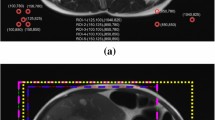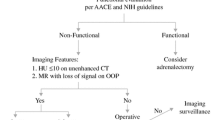Abstract
Purpose
Distinguishing stage 1–2 adrenocortical carcinoma (ACC) and large, lipid poor adrenal adenoma (LPAA) via imaging is challenging due to overlapping imaging characteristics. This study investigated the ability of deep learning to distinguish ACC and LPAA on single time-point CT images.
Methods
Retrospective cohort study from 1994 to 2022. Imaging studies of patients with adrenal masses who had available adequate CT studies and histology as the reference standard by method of adrenal biopsy and/or adrenalectomy were included as well as four patients with LPAA determined by stability or regression on follow-up imaging. Forty-eight (48) subjects with pathology-proven, stage 1–2 ACC and 43 subjects with adrenal adenoma >3 cm in size demonstrating a mean non-contrast CT attenuation > 20 Hounsfield Units centrally were included. We used annotated single time-point contrast-enhanced CT images of these adrenal masses as input to a 3D Densenet121 model for classifying as ACC or LPAA with five-fold cross-validation. For each fold, two checkpoints were reported, highest accuracy with highest sensitivity (accuracy focused) and highest sensitivity with the highest accuracy (sensitivity focused).
Results
We trained a deep learning model (3D Densenet121) to predict ACC versus LPAA. The sensitivity-focused model achieved mean accuracy: 87.2% and mean sensitivity: 100%. The accuracy-focused model achieved mean accuracy: 91% and mean sensitivity: 96%.
Conclusion
Deep learning demonstrates promising results distinguishing between ACC and large LPAA using single time-point CT images. Before being widely adopted in clinical practice, multicentric and external validation are needed.

Similar content being viewed by others
References
Sherlock, M., Scarsbrook, A., Abbas, A., Fraser, S., Limumpornpetch, P., Dineen, R., & Stewart, P. M. (2020). Adrenal incidentaloma. Endocrine Reviews, 41(6), 775-820.
Reimondo, G., Castellano, E., Grosso, M., Priotto, R., Puglisi, S., Pia, A., ... & Terzolo, M. (2020). Adrenal incidentalomas are tied to increased risk of diabetes: findings from a prospective study. The Journal of Clinical Endocrinology & Metabolism, 105(4), e973-e981.
Bovio, S., Cataldi, A., Reimondo, G., Sperone, P., Novello, S., Berruti, A., ... & Terzolo, M. (2006). Prevalence of adrenal incidentaloma in a contemporary computerized tomography series. Journal of endocrinological investigation, 29, 298-302.
Boland, G. W., Lee, M., Gazelle, G. S., Halpern, E. F., McNicholas, M. M., & Mueller, P. R. (1998). Characterization of adrenal masses using unenhanced CT: an analysis of the CT literature. AJR. American journal of roentgenology, 171(1), 201-204.
Boland, G. W., Blake, M. A., Hahn, P. F., & Mayo-Smith, W. W. (2008). Incidental adrenal lesions: principles, techniques, and algorithms for imaging characterization. Radiology, 249(3), 756-775.
Seo, J. M., Park, B. K., Park, S. Y., & Kim, C. K. (2014). Characterization of lipid-poor adrenal adenoma: chemical-shift MRI and washout CT. American Journal of Roentgenology, 202(5), 1043-1050.
Bancos, I., Taylor, A. E., Chortis, V., Sitch, A. J., Lang, K., Prete, A., ... & Arlt, W. (2020). Urine metabolomic phenotyping for detection of adrenocortical carcinoma: still a long way to go–Authors' reply. The Lancet Diabetes & Endocrinology, 8(11), 877-878.
Fishman, E. K., Deutch, B. M., Hartman, D. S., Goldman, S. M., Zerhouni, E. A., & Siegelman, S. S. (1987). Primary adrenocortical carcinoma: CT evaluation with clinical correlation. American Journal of Roentgenology, 148(3), 531-535.
Bharwani, N., Rockall, A. G., Sahdev, A., Gueorguiev, M., Drake, W., Grossman, A. B., & Reznek, R. H. (2011). Adrenocortical carcinoma: the range of appearances on CT and MRI. American journal of roentgenology, 196(6), W706-W714.
Vanbrabant, T., Fassnacht, M., Assie, G., & Dekkers, O. M. (2018). Influence of hormonal functional status on survival in adrenocortical carcinoma: systematic review and meta-analysis. European journal of endocrinology, 179(6), 429-436.
Nader, S., Hickey, R. C., Sellin, R. V., & Samaan, N. A. (1983). Adrenal cortical carcinoma a study of 77 cases. Cancer, 52(4), 707-711.
Newhouse, J. H., Heffess, C. S., Wagner, B. J., Imray, T. J., Adair, C. F., & Davidson, A. J. (1999). Large degenerated adrenal adenomas: radiologic-pathologic correlation. Radiology, 210(2), 385-391.
Fassnacht, M., Arlt, W., Bancos, I., Dralle, H., Newell-Price, J., Sahdev, A., ... & Dekkers, O. M. (2016). Management of adrenal incidentalomas: European society of endocrinology clinical practice guideline in collaboration with the European network for the study of adrenal tumors. European journal of endocrinology, 175(2), G1-G34.
Lau, S. K., & Weiss, L. M. (2009). The Weiss system for evaluating adrenocortical neoplasms: 25 years later. Human pathology, 40(6), 757-768.
Erickson, B. J., Korfiatis, P., Kline, T. L., Akkus, Z., Philbrick, K., & Weston, A. D. (2018). Deep learning in radiology: does one size fit all?. Journal of the American College of Radiology, 15(3), 521-526.
Indolia, S., Goswami, A. K., Mishra, S. P., & Asopa, P. (2018). Conceptual understanding of convolutional neural network-a deep learning approach. Procedia computer science, 132, 679-688.
Islam, J., & Zhang, Y. (2019). Understanding 3D CNN behavior for Alzheimer's disease diagnosis from brain PET scan. arXiv preprint arXiv:1912.04563.
Huang, G., Liu, Z., Van Der Maaten, L., & Weinberger, K. Q. (2017). Densely connected convolutional networks. In Proceedings of the IEEE conference on computer vision and pattern recognition (pp. 4700-4708).
Rouzrokh, P., Khosravi, B., Faghani, S., Moassefi, M., Vera Garcia, D. V., Singh, Y., ... & Erickson, B. J. (2022). Mitigating bias in radiology machine learning: 1. Data handling. Radiology: Artificial Intelligence, 4(5), e210290.
Moassefi, M., Faghani, S., Conte, G. M., Kowalchuk, R. O., Vahdati, S., Crompton, D. J., ... & Erickson, B. J. (2022). A deep learning model for discriminating true progression from pseudoprogression in glioblastoma patients. Journal of neuro-oncology, 159(2), 447-455.
The MONAI Consortium (2020) Project MONAI. https://zenodo.org/record/4323059
Torresan, F., Crimì, F., Ceccato, F., Zavan, F., Barbot, M., Lacognata, C., ... & Iacobone, M. (2021). Radiomics: a new tool to differentiate adrenocortical adenoma from carcinoma. BJS open, 5(1), zraa061.
Elmohr, M. M., Fuentes, D., Habra, M. A., Bhosale, P. R., Qayyum, A. A., Gates, E., ... & Elsayes, K. M. (2019). Machine learning-based texture analysis for differentiation of large adrenal cortical tumours on CT. Clinical radiology, 74(10), 818-e1.
Bancos, I., & Prete, A. (2021). Approach to the patient with adrenal incidentaloma. The Journal of Clinical Endocrinology & Metabolism, 106(11), 3331-3353.
Dinnes, J., Bancos, I., Ferrante di Ruffano, L., Chortis, V., Davenport, C., Bayliss, S., ... & Arlt, W. (2016). Management of endocrine disease: imaging for the diagnosis of malignancy in incidentally discovered adrenal masses: a systematic review and meta-analysis. European journal of endocrinology, 175(2), R51-R64.
Bancos, I., Taylor, A. E., Chortis, V., Sitch, A. J., Jenkinson, C., Davidge-Pitts, C. J., ... & Young Jr, W. F. (2020). Urine steroid metabolomics for the differential diagnosis of adrenal incidentalomas in the EURINE-ACT study: a prospective test validation study. The lancet Diabetes & endocrinology, 8(9), 773-781.
Espinasse, M., Pitre-Champagnat, S., Charmettant, B., Bidault, F., Volk, A., Balleyguier, C., ... & Caramella, C. (2020). CT texture analysis challenges: influence of acquisition and reconstruction parameters: a comprehensive review. Diagnostics, 10(5), 258.
Acknowledgements
The authors are thankful to Mayo AI lab, Radiology, Mayo clinic, Rochester, MN, USA.
Funding
None
Author information
Authors and Affiliations
Corresponding author
Ethics declarations
Conflict of interest
The authors declare that they have no conflict of interest.
Additional information
Publisher's Note
Springer Nature remains neutral with regard to jurisdictional claims in published maps and institutional affiliations.
Supplementary Information
Below is the link to the electronic supplementary material.
Rights and permissions
Springer Nature or its licensor (e.g. a society or other partner) holds exclusive rights to this article under a publishing agreement with the author(s) or other rightsholder(s); author self-archiving of the accepted manuscript version of this article is solely governed by the terms of such publishing agreement and applicable law.
About this article
Cite this article
Singh, Y., Kelm, Z.S., Faghani, S. et al. Deep learning approach for differentiating indeterminate adrenal masses using CT imaging. Abdom Radiol 48, 3189–3194 (2023). https://doi.org/10.1007/s00261-023-03988-w
Received:
Revised:
Accepted:
Published:
Issue Date:
DOI: https://doi.org/10.1007/s00261-023-03988-w




